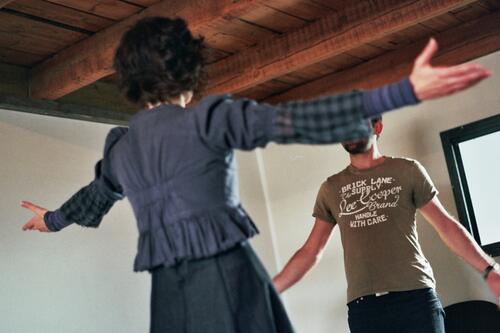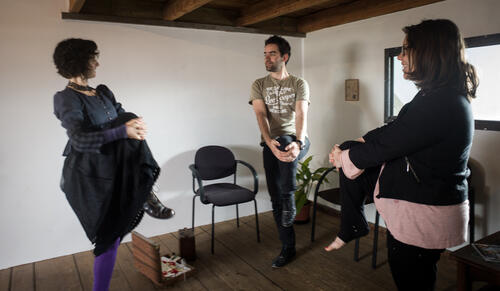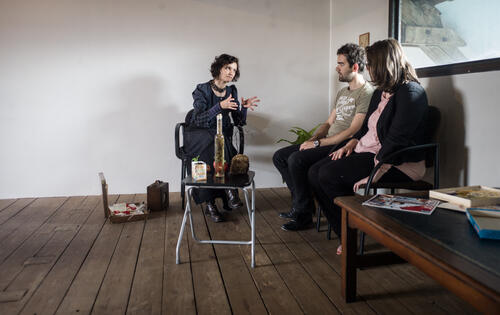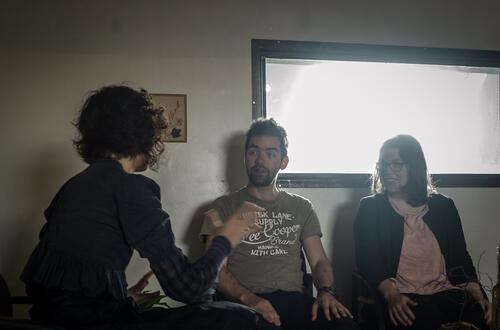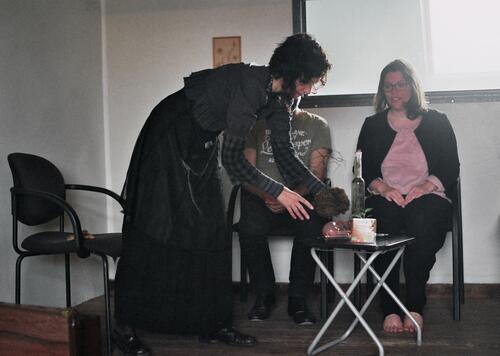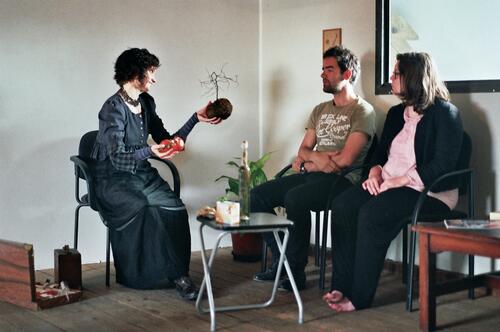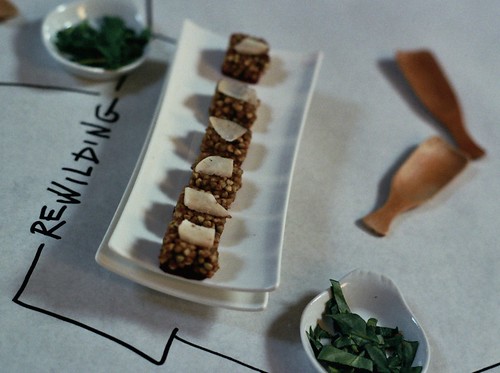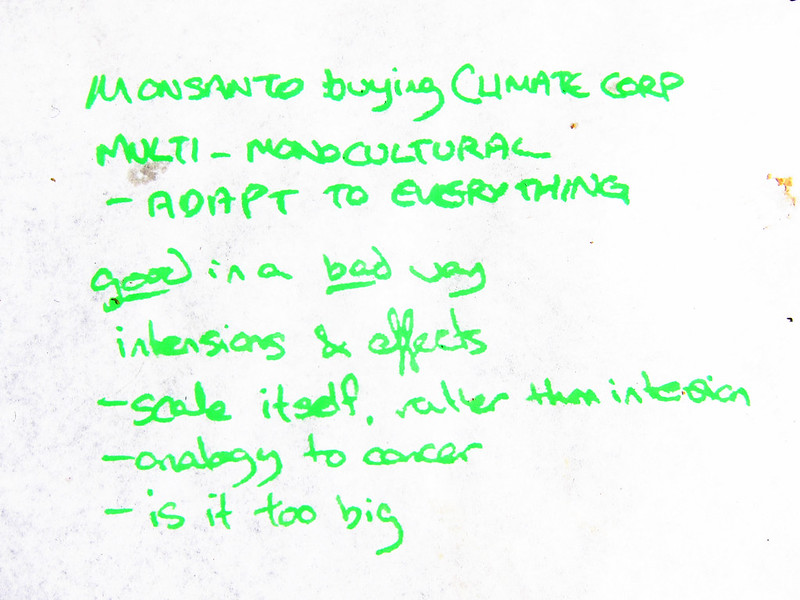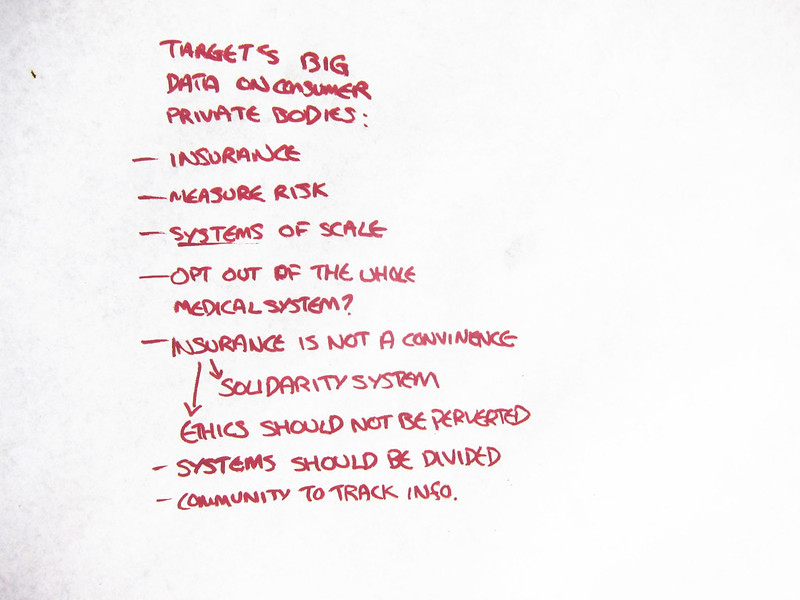Fringejoyride Residency Notes
Microresidency by Lisa Ma at FoAM Brussels 20140407 → 20140413, as part of the Future Fabulators project. The residency consisted of a series of discussions, concept development, co-creation and scenario building sessions, where Lisa was assisted, guided and mentored by the FoAM team (Maja Kuzmanovic, Nik Gaffney, Rasa Alknsyte and Michka Melo).
In preparation for the microresidency, FoAM hosted a scenario building workshop on human invasive interaction, in October 2013, in collaboration with Timelab at Vooruit in Ghent.
Read about Lisa's experience of the microresidency in the fringejoyride residency review
Session I: Notes 20140407
OEmbed Error
|  |
Begin developing notes on the luddites
Origins of research
- human-animal relationships (in the city and elsewhere), what do we do with animals we don’t eat? examples of wild boar in Berlin, chickens in China, horse meat in UK, wild geese (and other invasives) in Ghent
- interested in looking at changing the way that ecology is used and controlled
- the project in Ghent with TimeLab, entitled “nothing is lost”, waste as a source etc. lisa looked at human-animal relationships in the fields of linguistics, food, health and science. slightly difficult interaction with science who see the project as “a spanner in the works” and argue that popularising eating invasive species is dangerous, as the demand might encourage people to begin farming these animals and plants.
- during the Ghent project Lisa found the need to contextualise the practice wider, in order to avoid it becoming a stereotypical food movement (either a hippy-like malnourished food activism, or a glitsy hipster invasivore diet). it seems like the project might be opening doors that are already open… Lisa wants to use the project in Ghent as a test-lab or a prototype for the biotech sphere she is researching.
- Lisa is interested in fringe communities and different forms of ethnographic activism (for example “farmification” of the joystick factory), that are productive, non-violent forms of protest against the status quo (e.g. people hunting and eating invasive geese, or a cake maker using knotweed instead of rhubarb for cheese cakes). as opposed to loud clicktivism and slacktivism, this kind of activism is focused on quiet, labour intensive / productive activism, that isn’t asking for attention.
- at the same time Lisa is working with the Near Now in Nottingham to develop the activist part of the work. Nottingham is a town where both Robin Hood and Luddites originated - both activists in very different times, rebelling against the wealthy (Robin Hood against the aristocracy, Luddites against the merchant class in the early Industrial Revolution). Although Luddites’ actions were against industrial machinery, they were not opposed to using any technology (being lacemakers and artisans themselves) - they were opposed to the industrialisation of technology, oppressive systems in which mechanised looms were used in burgeoning textile factories mass producing cheaper, lower quality stuff. In order to be recognised by the powers that be, they came up with an imaginary king (Ned Ludd) and their actions were quite militant. Lisa is wondering about who are the contemporary luddites in the context of a biotechnological ®evolution in the everyday life, and what are their modes of action? They go beyond what is popularly known as the luddites of digital technology (people opting out of fb and twitter for example). It isn’t as easy to opt-out of bio-technology as it is to not use facebook. Suggestion: look at the luddite interpretations in the Dark Mountain books.
Microresidency at FoAM
- During the microresidency Lisa would like to work on contextualising practical work in Ghent and theoretical/speculative work in Nottingham, leading towards a meme for a speculative bio-luddite movement. to do that, Lisa would like to contextualise her work in biotechnological sphere (with invasives for example) in the evolution of the luddite movement(s). At the cross-section of biology (or biotechnology) and luddite movements Lisa speculates what a bio-luddite movement would look like, and what their actions might be. As the aim of the microresidency Lisa would like to sketch-out (in text and images) a scenario for a “bio-luddite in everyday life” (possibly in the doctors’ waiting room) and come up with a series of 'bio-luddite conundrums' - questions about real and imagined situations that could be posed to (aspiring) luddites, to define the the scope and the edges of this movement.
- we had an extensive discussion about what to consider biotechnology (or technology in general). Lisa is an advocate of Kevin Kelly’s view that technology is anything that extends the human organism. Lisa mentioned invasives as an example of something that isn’t biotechnology - they are feral, not domesticated, not evolved for human use. they are things that have their own intentionality outside of the human use. we came to the conclusion that the edges of biotechnology are quite blurry, as there are many interrelated fields - is bio-sociology and critique of biotech a part of the biotechnological sphere? is there a distinction between the tools and the social sphere? Suggestion: look at tactical biopolitics
- bio-hacking: are bio-luddites a parallel parody of biohackers. even though biohackers are democratising science, in Lisa’s opinion, there isn’t enough social critique in the field (suggestion: look at the biopunk manifesto by Meredith L. Patterson)
- Bio-luddites are people who question and productively critique the use of biotechnology in the everyday. As a (speculative) movement, Lisa would like to give bioluddites a brand, or a meme, under which all the disparate movements and events might be joined. she’d like to create a momentum for a critical dialogue around biotech that should be happening… and attempting to model a new relationship with politics
- there is much talk about “not having time” to be engaged in activism. however, we spend a lot of our time waiting (in doctors’ waiting rooms, train stations, on planes…) - how can bio-luddites use these 'glitches' in time to use them productively for activist interventions?
- what would be a speculative scenario of a bio-luddite action reaching people in a doctors’ waiting room? how can bio-luddite activism be implemented in the waiting room? Lisa is interested in the people who 'consume' (or are effected by) bioluddites' works. the waiting room could be a place for recruiting - there is a bit of a bioluddite in all of us (as we cannot easily opt-out of the biotechnological sphere of influence, we necessarily have an opinion about it and a position in it)
- the first event Lisa will present at is Luddites 200 (David King is one of the founders).
- the king and the merchant class were the targets of the original luddites, they used military techniques to attract attention. what are the equivalents of militant actions today? service and experience design? what experiences would bio-luddites offer to enact different approaches to everyday biotech? the original luddite’s actions had very high stakes - what would be the equivalent today? what would be the bio-luddite’s equivalent of Occupy?
- Luddites add the dimension of morality to the technological discussion. What are the bio-luddite’s moral criteria for use of biotech? what is their dilemma?
- Suggestion: in order not to get lost in the multiplicity of research, how about starting with biotech in daily life, a specific situation (such as the waiting room) and speculate about a specific bioluddite conundrum that might be initiated or resolved there.
How can FoAM assist
- co-creation of the waiting room scenario
- co-creation of bio-luddites’ conundrums
- collating research notes
- presenting work in progress as something substantial and relevant
Research questions
- who are the contemporary luddites in the context of a biotechnological ®evolution in the everyday life (bio-luddites), and what are their modes of action?
- what is the role of bio-luddites in the everyday life, and in the biotechnology sphere?
- what are the edges of biotechnology in the broadest sense of the word (i.e. what is NOT biotechnology, or where does the technology stop)?
- where is the locus of control in the biotechnological sphere?
- is bio-sociology and critique of biotech a part of the biotechnological sphere?
- how can bio-luddites use the 'glitches' in time, while we’re waiting, to use them productively for activist interventions? how can waiting times be used for bio-luddites (would it be doing things with friends and family)?
- what would be a speculative scenario of a bio-luddite action reaching people in a doctors’ waiting room?
- how does biotechnology become socialised?
- should we socialise activism and biotech and if yes, how?
- what would be examples of issues/technologies that luddites could respond to?
- what questions do you want to ask the people at Luddites 200?
- what are the equivalents of militant actions today? service and experience design?
- what experiences would bio-luddites offer to enact different approaches to everyday biotech?
- what are the appropriate technologies for bioluddites? what are the bio-luddite’s moral criteria to use biotechnology?
- what would be in the bio-luddite manifesto? what is the bio-luddite’s dilemma?
- what is the ethical continuity along the biotechnological supply chain?
- what are the bioluddites’ conundrums? their unanswerable questions that incite discussion?
To do before session II
Session II planned for afternoon of Tuesday 20140408. Before that, there are a few things to do:
- Lisa: excerpts from the visual research in China, Ghent, Berlin… to visualise what are possible bio-luddite conundrums, and how they are interrelated.
- FoAM: continue feeding the background research notes and think about answers to research questions
Session II: Notes 20140408
Reflection on yesterday's session:
Rasa: we're slowly getting more clarity on what the residency should result in (e.g. waiting room scenario + bio-luddite conundrums
Nik: interesting to look at different perspectives of luddites.
Maja: are bioluddites speculative or a real movement? need to do more research on luddites in history and present
Lisa: bioluddites are borderline between speculative and real; presented as if it was already happening, based on things that are happening but fictionalised/parodied..; the question of defining technology as too narrow on one hand or ungraspable on the other is interesting and needs clarification; the differences in approaches to the notion of desire in science and design are interesting to look into.
Bioluddites in waiting rooms
Aims
What do bio-luddites aim to do in waiting rooms?
- usurping/using the waiting time (aka down time, wasted time, a glitch in the productive time) for their own purposes
- recruiting
- passing skills
- relating the innocent doctors' visit (like getting a flu shot) to the wider issues of living in a biotechnological sphere
Bio-luddites
How do we recognise a bio-luddite?
The proposed bioluddite is more active than the current luddites. Rather than focusing on writing, they focus on action, creating experiences and making. Bioluddites are protagonists of the DIY maker culture, but stay away from neophilia. Doers at heart, bioluddites value knowledge in action and putting theories into practice. As such they became living examples of their principles. They do not preach, but provide experiences (e.g. conversation is valued much more than a pamphlet). Some of their actions come close to the “survivalists”, but without the pessimistic dystopian world view - they are keen to know and use survivalists' techniques in order to pro-actively improve the status quo. Their worldviews come close to the opposition movements, but they have a clear goal about the powers that control today's technology advancements.
They practice principled opposition, embodying their worldview with consequential thought from a social perspective in everything they do - from eating breakfast to organising global bio-luddite gatherings.
In their lives and tactics bioluddites embrace adaptability and flexibility as their guiding principles. As availability of resources and context of action change, they adapt to the new conditions. They hold their strong opinions somewhat weakly, to be able to continue existing in a changing environment. Although some of their philosophies might appear similar to those of contemporary hippies, they are better dressed (anarcho-dandy style, with a wink to the luddite times) and better fed than hippies. In general, bio-luddites take very good care of themselves and are often members of the slow-food movement.
They value everyday life, which they do not want to disrupt but “slot into”, while fighting against new intrusions into their ideal of daily life.Their actions deal with changing supply chains to resolve both social and environmental issues, closing technological loops, increasing awareness and accessibility of biotechnology, living with and in the local environment, re-valuing leisure, etc. Their primary mode of action is connecting different systems and worldviews together (for example the cake shop selling knotweed instead of rhubarb cakes after a bioluddite action to encourage eating invasive species). They prefer conversation to destruction, but their tactics are not necessarily pacifist - they are a bricolage of approaches that range from friendly constructive criticism, to obstructing production and distribution processes. Bioluddites are not against biotechnology itself, but against power structures the technology is used within: they are keenly aware of the agency involved in dealing with biotechnology and the effect it can have on society. They advocate transparency and openness of sources, to allow individuals and communities to make moral and ethical judgements in regard to technology. Society and the environment come first, technology is secondary.
Waiting Rooms
What are the most common physical, temporal, emotional and mental characteristics of waiting rooms in doctors' practices?
general ambiance
- not much natural light (tiny windows, curtains/blinds)
- artificial light, usually fluorescent
- sounds: muzak, non-slip shoes, coughing and sneezing, crying babies, doctor's equipment buzzes, phone ringing from
- colours: neutral, muted and frosted glass
- smells: cleaning products, dust, patients
- in expensive private practices, the waiting rooms look like spaceships or furniture stores…
- no privacy
- queue and flow can be smooth or stressful (if you don't know when is your turn)
furniture:
- uncomfortable chairs
- (yellowing) insulation tiles on the ceiling
- wall paper
- big wooden doors
stuff:
- (old) posters
- (bad) art
- fiddle-proof furniture
- TV (sometimes with fireplace simulations)
- magazines and pamphlets
- toys for kids
time:
- a sense that things change much slower
- time stretches
- timelessness
people:
- grumpy receptionist
- smiling nurses
- survey researchers
- patients
- cleaners
actions:
- sitting
- reading
- staring (into space or at the screen)
- playing with your phone
- shifting
- talking…
- enjoying doing nothing
- voyeurism
in your mind:
- stressed about the procedure
- helpless
- preparing preemptive explanations
- relaxing to have 'time off'
- worried about time taken off
- being annoyed by other patients (talking, doing stuff, making a mess, being to close and infecting you…)
- bored
bioluddite actions in waiting rooms
What could bioluddite activism in waiting rooms look like?
(ordered from simple to more complex and expensive)
- Waiting stoically like a tree (and embodying bioluddite principles)
- Physical activity (leading by example)
- spontaneous ballet class
- Good gym model
- (engaging people in) Conversations
- give compliments
- read fortunes
- charismatically engaging people in conversations which subsequently lead towards bioluddite topics
- rant about the “evils” of biotechnology (in the doctors' practice)
- 2 well dressed bioluddites in animated conversation about integrative medicine, sharing samples and offering them to the other patients
- Taking charge (organised leading and reshuffling of people)
- putting people in a row
- naming yourself as the group leader and animating the patients
- Research surveys (on bioluddite topics)
- Improv performances
- liminal (near real, slightly off) conversational pieces to attract people's attention but not look acted
- circle of knitting ladies
- singing in front of the fire place
- Raising awareness and skills related to healthy food and cooking (live or on TV)
- cooking programme with live preparation
- cooking classes
- cooking show
- Portable bioluddites' kits
- Collecting CO2 for plants in the garden
- Miniature bioluddite gardens/ecological habitats (opposite to farmville)
- bioluddite puzzle pieces that need everyone in the room to be put together
- Sharing the joys of the microbiome
- collecting bacterial samples from patients and/or waiting room
- sharing small culture samples as gifts/presents
- Ambient bioludditism: interior design interventions
- non-symbolic action
- paint the walls
- work with the doctors' practice to create a bioluddite waiting room, with BL approved paints, furnishings, lighting… with clearly marked sources and donation schemes
- put emoticons on every poster
- put “please” stickers on every poster
- magazine inserts and petty acts of vandalism
- soviet style motivational posters
- Changing architecture: making waiting rooms more playful/mobile
- Ferris wheel
- Ski lift
- Conveyor belt
- Mobile surgeries
- mobile waiting spaces (that come and collect you from home and deliver you to the doctor)
Morning discussion
What are bioluddites' actions and how are they motivated? The waiting room discussion was a good start, but pointed to the holes in our understanding of who bioluddites are. Lisa began to search for an answer through a visual survey of her ethnographic imagery. Several clusters and themes emerged:
- what is the etiquette of the bioluddites?
- misguiding/playful/questioning (mis)labelling (e.g. poison cupboard in the kitchen)
- infiltrating mental pollution devices, such as magazine racks, posters and TV screens in waiting rooms
- non-domestic aesthetics of technology; well designed communal technology on a human scale, its design radiates competence and confidence
- bioluddite's actions fit into popular imagination and tweak them only slightly. if you don't know it's an action, it might look exactly as you imagine a situation to be (e.g. industrial animal market)
- a bioluddite's product is not always available, you have to chase after it rather than expect it to always be available like non-perishables in a supermarket. Think of the ritualised sound of a spontaneous ice-cream truck, or mobile sellers like sandwich trucks (or alternatively, animal protein packaged to be eaten on the go, on a stick, such as kebabs).
- bioluddite's actions are mobile, they might have a mobile kitchen/pharmacy, a closed loop system where animals are kept, slaughtered, prepared, served and disposed of, in hygienic circumstances, using well designed bioluddite technology
- bioluddites are open about their sources and use displays of their wares to encourage trust and verify authenticity of their produce (whole animal displays, even celebrating displays of 'ugly' parts of the biotech process…)
- large (global) bioluddites' gatherings are organised regularly, where they invite sharing and participation of everyone involved. They prefer Unconferences to traditional conference setups.
- to invite a wide public and demystify bioludditism, they often hold open houses and show displays of bioluddite labs, kitchens, libraries - a display of their everyday life, using themselves as role-models.
- There are different recruiting techniques for different audiences: some are recruited to become fellow activists, others as customers, others again as bioluddites to be (children and animals)
- the bioluddite actions happen in environments where high contrast is present, where natural and artificial co-exist (e.g. farming an abandoned theme park, changing the menu of a McDonalds in a melancholic Chinese countryside, having a photo-shoot with a decaying pig's corpse on a popular beach…)
- their lifestyle attempts to surface the antagonisms that exist around them (e.g. caged grass, beautifully staged displays of ferocious animals, nostalgia of rural lifestyles in hyper-urban environments…)
- bioluddites point out and frame biotechnological and capitalist glitches in the world around them
- bioluddites connect urban and rural populations, city dwellers to the living environments around them - they take people out of the architecture of the modern space
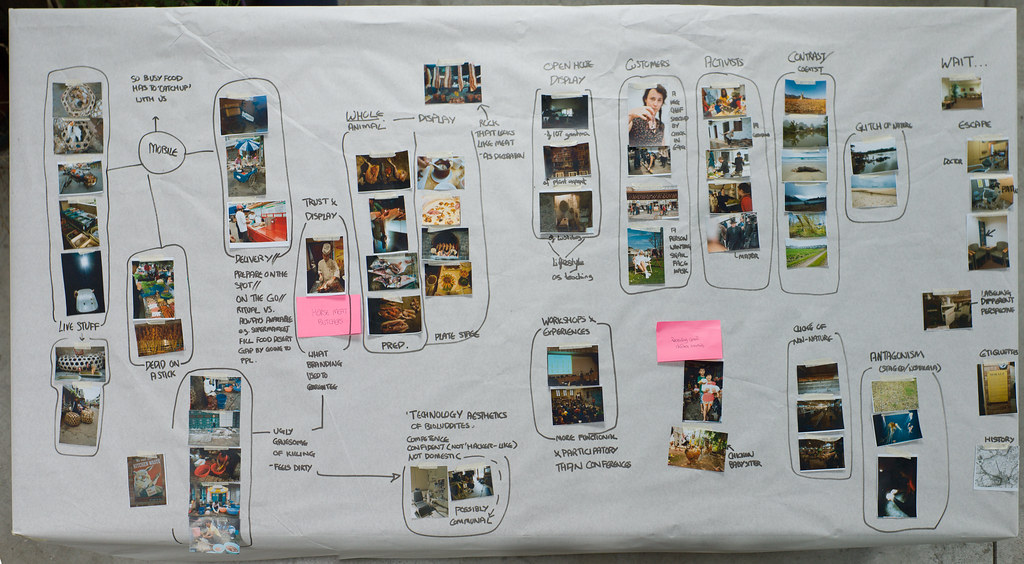
Other reflections
- Displays of food tend to be used as verification of authenticity (making dumplings in the window, cutting sashimi in front of customers…) - implying that there might be a lack of trust between the service provider and the customer. Today a lot of the trust issues have been transferred to brands and trademarks, initially set-up as guarantees of quality, now more of a social proof of status (except for eco-certificates). An example where the display goes against quality, but stands for a principle (halal): the Australian sheep are shipped alive to the middle east, only so the local butchers can kill them in the 'proper' way. There is no trust in the Australian butchers to do it properly, even if that means that the meat will be of lower quality due to the animal conditions from the long transport. In the bioluddite context, this might mean exposing or visualising otherwise invisible parts of the biotechnological process (e.g. ritually displaying all ingredients of an inoculation). The aesthetics of the display is important to a bioluddite: it might be something in between a chinese medicine shop and a bio-lab. The question about displays and bioluddism is: how do you verify something for yourself without knowing how to 'do biotechnology'?
* Could networked pyramid-like schemes (with multiple centres) be a viable alternative to the mainstream market economy, where bioluddites could work with homesteads and small co-ops; with two differences to the common pyramid schemes - that everyone in the network/pyramid appreciates and uses the products, rather than being in them just for the money and that the supply never grows beyond the need. Could bioluddites use old (pre-industrial?) economic forms and adapt them to new contexts?
- How can bioluddites insert themselves into the chain of trust between doctors and patients, food providers and eaters, scientists and their objects of investigation? Should they always do something 'relatable' (i.e. should they go for GPs or dentists)?
Afternoon discussion
Lisa & Maja researched separate tracks. Maja read up on the Luddites of the past and present to flesh out the notes on the luddites. Lisa researched about dandyism, the Amish, neo luddites and other tracks. We came back together after a couple of hours and continued the discussion:
- could bioluddites be something like lifestyle coaches?
- Lord Byron was both a dandyist and a Luddite
- the earliest dandies were the first celebrities and taught society about personal hygiene… anti geek/transhumanist/businessman
- bioluddite retreats - holidays from biotech, similar to social network retreats
- “curating lifestyles” - being a human biotech filter, helping to choose appropriate biotechnologies
- bioluddites mid-emerging technologies with traditional approaches using a strong ethical filter; they help people find their way through the jungle of biotechnologies on offer
- grandmothers as mentors, ambassadors of bioluddite conundrums, rather than give specific expert answers
- doctors could have bioluddites in residence, who never force but inspire
- bioluddites could have clinics with a social identity, making small tweaks in people's lifestyles, preventative approaches (like the quantified self); they might deal with addictions that aren't perceived as such - sugar, sitting, mental, adrenaline, coffee, pollution… their treatments could be mock-torture therapies; little tricks to play with people's psyche; enacted conundrums; immersive situations and scenes
- they provide experiences that can't be explained in a simple piece of technology - they're against gadgets…
- on the one hand they are dandyfying the status quo through parodies inserted in daily situations, on the other hand they provide experience prototypes of how things could be otherwise. they are playing with the edges between the prototypes and reality - pointing out problems in a ludic manner, using holistic approaches
Summary:
- bioluddites' motives are primarily social
- they advocate human-scale, appropriate technology and 'anticipatory design'
- they value wisdom and knowledge
- they work with habits and ailments of contemporary lifestyle (though not as serious ones as addiction)
- they offer experience prototypes and parodies of real life in the state-industrial complex, showing the faults and tearing on its edges
- they are pro-choice so people are not 'slaves to technology'
Session IV: Notes 20140410
Selecting relevant themes from food_scenarios to chart bioluddites' biotechnology sphere
Planning the research gathering
Bioluddite Menu
- Wild food sushi
- Pickled garlic and nuts
- Steamed artichoke flower with jerusalem artichoke dip
- Potato peel chips with truffle oil
- Mock meat meal on a stick
- Raw chocolate snuff, persian fairy floss
Drinks:
- Water kefir
- Sweet basil water
- Herbal teas
- Cube cola
- Feral trade coffee
- Local micro-brewed beer (perhaps Dark Sister or Taras Boulba or…)
- Home made absinth for the brave
Dress code
What would a bioluddite dandy look like?
Annotations of Maja's Bioluddite costume 20140411:
- Shrug made from invasive possum fur in New Zealand (anno 2014)
- Wool and reflective fibre broche by a young designer in Iceland (made so cars can see you riding a bike at night) (anno 2013)
- Organic cotton crocheted necklace by a Polish crafter in Maja's neighbourgood (anno 2013)
- Organic cotton top by a Swedish designer, based on patterns from Luddite times (anno 2010)
- Stretch silk dress gifted by a Dutch fashion design student in exchange for modelling services (anno 1996)
- Linen underskirt with embroidered hem bought on the local flea-market (anno ~1930)
- Stretch cotton sleeves made from Maja's old stockings (bought in Yugoslavia, 1990)
- Outdoor merino wool underwear from New Zealand (anno 2008)
- Handmade distressed leather shoes from San Francisco (anno 2013)
Flow
- 5-6 Apero with informal discussions on health, food, diy biology…
- ~6 short presentation of the research by lisa, q&a
- introduction to the edible bioluddite map and tasting foods & drinks
- lisa propose a few bioluddite conundrums, discussion about how a bioluddite might react
- drinks, food and conversation in the 'waiting room' or around the table
- personal experience with a bioluddite coach (maja), for those who'd like to apply bioluddism in their daily life
- throughout: documentation (photo, video)
Planning
Thursday
- make bioluddite's etiquette chart (or a biotech sphere chart) for the coaching room (Maja, Nik, Lisa)
- come up with at least 3 conundrums (Lisa)
- decide on spaces and materials for the research gathering (Rasa, Lisa)
Friday
- Food shopping, preparation and presentation (Rasa, Maja)
- Prep presentation (Nik, Lisa)
- Documentation (Nik, Lisa, Rasa)
- Hosting (Lisa)
- Bioluddite enactment (FoAM)
Saturday
- compile documentation and put stuff online, tidy up notes, link pages
- conclude waiting room scenario, write it up and possibly make a visual collage of it
- write a blog post
- visit Rasa's garden
Sunday
- final wrap-up and departure
Bioluddite conundrums
- what do you think Climate Corporation being sold to Monsanto?
- should biotechnology be used to feed the growing population in Asia?
- would you like to be told that you are very likely to develop an incurable disease within a few years? Should a doctor automatically give such information to a patient? Genetic screening has raised this issue by giving doctors the ability to diagnose genetically related (but still untreatable) disorders…
- should we use invasive species as a resource?
- when asked about the amount of medical help one would choose in a dire situation, most doctors choose to die at home without medical help, arguing for a quality of life rather than quantity. http://www.theguardian.com/society/2012/feb/08/how-doctors-choose-die How should that affect the rest of our seemingly obvious choices about survival? Are doctors role models?
- in 2012, Target the consumer store sent baby coupons to a teenage girl who had not told her parents she was pregnant http://www.forbes.com/fdc/welcome_mjx.shtml What's the role of companies in our seemingly private bodily changes?
* Is elaborate biomimicry biotechnology or is it just technology borrowing from biology?
- Pandas have very little effect on their habitat and are extremely expensive to maintain. in 2012 Canada spent $10million renting pandas from China during budget cuts elsewhere http://www.bloombergview.com/articles/2013-08-27/why-i-hate-pandas-and-you-should-too. Pandas have little hope of breeding in the wild. Should we keep up with this fetishized animal’s lack of affordance to survive?
- Why do Cooking channels not making ppl cook more while smoking /drinking makes ppl more prone to smoke/drink?
- Is rewilding an aristocratic conservation crossing with fantasy themeparks that drives food-production to poorer countries? Should we support this luxurious attempt at a wilder aspiration?
- Is recycling keeping the human population in a better balance with the environment or is it only a marketed loophole for the conscience?
- When to use biofuel and why?
Bioluddite charter
In the afternoon we distilled our notes and thoughts into the beginnings of a Bioluddite charter with the following sections, based on Chaordic principles (used for example here.
- Purpose/Preamble – That which identifies and binds the community together as worthy of commitment and personal effort. An unambiguous vision or concept of the future.
- Principles – The behavioural aspirations of the community. (…) Must have a high degree of ethical and moral content, which does not prescribe behaviour but guides it.
- Concept – A general view of the best possible institutional embodiment of purpose and principles. A general picture of the desired relationships.
- Structure – The specific anatomy of the organisation. The contract of rights and obligations between all members of the community.
- People – The initial members of the community and the leadership essential to effective initiation and evolution of the purpose, principles and structure.
related:



